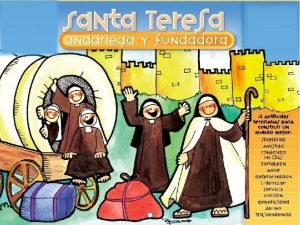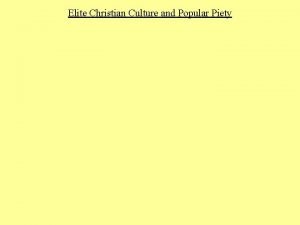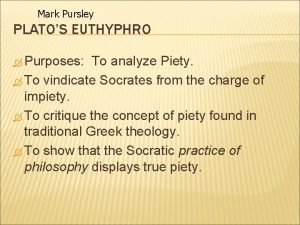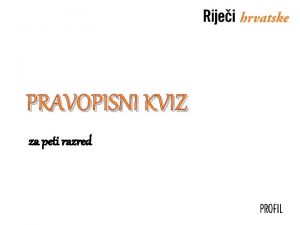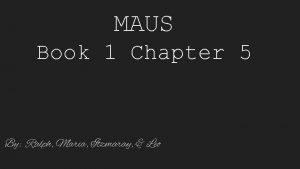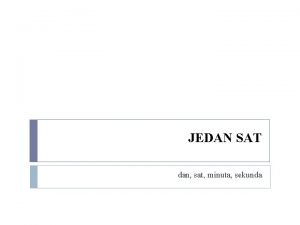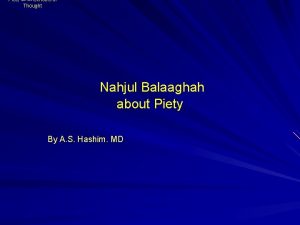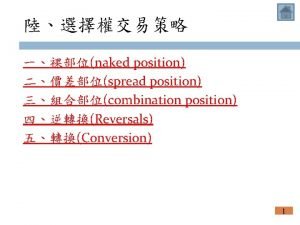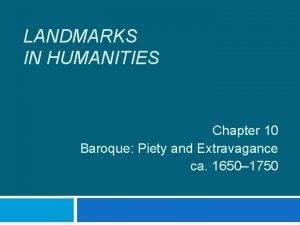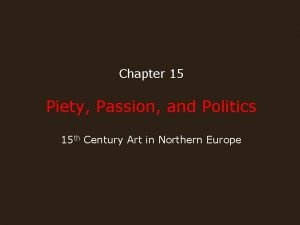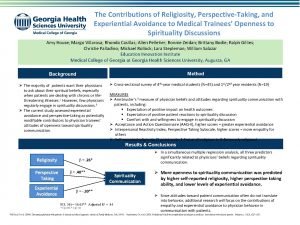PIETY RELIGIOSITY POSITION OF MALA AND MAWLUD IN























- Slides: 23

PIETY & RELIGIOSITY: POSITION OF MALA AND MAWLUD IN MAPPILA MAKING MUHAMMAD RAZI T DARUL HUDA ISLAMIC UNIVERSITY

WATCH WORD MORE THAN A LITERARY GENRE, AS CONCEIVED BY MANY, MALA AND MAWLID ARE PERFORMATIVE, GENERATIVE, MAPPILA MAKING GENRE.

THE SUFISTIC MAPPILA TRADITION The advent of to Kerala was through Arab traders and seafaring Sufis. Traditional mode- accepts Mala and Mawlid as devotional as well as literary works Reformative mode- negates the devotional aspects while accepting the literary prowess.

THE MAPPILA GENRES Mappilas were renowned bibliophiles from very early centuries. They TWO were also prolific writers and wide readers. CATEGORIES: 1) Great literature – serious discussions 2) little literature – devotional purposes

MAPPILA LITERATURES, IN GENERAL AND MĀLAMAWLID LITERATURE, IN PARTICULAR, HAVE PLAYED A MAJOR ROLE IN BRINGING MAPPILAS UP IN THEIR RELIGIOUS AWARENESS AND SELF-PRESTIGE. STARTING CENTURIES BACK, IT WORKS STILL NOW AS A VIBRANT PRESENCE, WHICH CAN MEASURE THEIR INTENSE RELIGIOSITY AND DEPTH OF IMAN. THE DIFFERENCE IS THAT: MAWLIDS ARE A TRANSNATIONAL GENRE IN THE MIXED FORM OF PROSE AND VERSE, AND MĀLAS ARE MOSTLY AN INDIGENOUS ORIGIN IN VERSE.

MAPPILAPPATTU MALAPPATTU (SONGS OF MAPPILA) HAS VARIETY OF TYPES: MALAPPATTU (Song of chain), PADAPATTU (Song of war), KHISSAPATTU (Song of story) , KALYANAPATTU / MAILANCHIPATTU (Song of wedding) , MADHUPATTU (Song of praise), THADIURDIPATTU (song of advice), KATHUPATTU (Song of letter) AMONG THEM MALAPPATTU GOT MASS POPULAR SUPPORT DUE TO ITS MASTER SIGNIFIER OF SPIRITUAL INTUITION. ACCORDING TO THE DIVERSE SUBJECTIVITY, DIFFERENT SECTIONS ALSO FOUND IN MALAPPATTU.

MĀLA LITERATURE Its origin had particular reasons related to its social, political, religious and cultural backgrounds, social functions and communal responsibilities. Mālas were a very comprehensive and all encompassing system of educating Mappilas Composing notable works on various subjects such as Islamic history, biography, religious advice, social criticism, spirituality, etc As a system of education and creating awareness, the sections like women and children also got due considerations in this cognitive literary movement.

LITERARY INFLUENCES It Have Been Influenced By Arab Muslim Devotional Songs Thematically And Local Traditional Devotional Songs In Typologically It’s Geography Had Been Influenced By Multiple Diasporas Cultural Assimilation And Other Unique Cultural Dialogues . During The Time When Malappattu Was Written, The Land Was Abundant With The Numerous Hindu Religious Devotional Songs And Hymns. The Authors Of Poem Dare To Make Integration Between The Poetic Typology Of Kerala And Arabia

FEATURES OF MALA LITERATURE Every Poem Starts With Bismi, Hamd & Salat Praising Of Highly Spiritual Bound Advocates Has Been Considered As The Focal Point For Themes In Malappattu. Striking Distinctiveness Of These Songs Is The Proportional Mixture Of Multiple Languages Rather Than A One Language. Arabic, Persian, Tamil, Malayalam, Sanskrit Are Mixed In A Single Idealistic Platform, What Anyone Call Piety Expression

INFLUENTIAL MALA WRITINGS A wide corpora of Malas have appeared among Mappilas dealing with variety of Subjects The prime work in Mala Genre is Muhyudheen mala, Kazi Muhammad bin Abul Aziz, at 1607 CE. It codified in 157 lines. This poem had much relevance in the focal sociopolitical scenario of Seventeenth century South India. It was the time of emerging anti-colonial, anti-feudal movements

OTHER PROMINENT MALAS Rifae Mala- Unknown Author Nafeesath Mala - Nalakath Kunchi Moideen Ibrahim Bin Adham Mala -Kottakunnan Muhammad Siddequmala, -Manachan Pirakath Abdul Aziz Hamzath Mala, -Kunchi Seethi Koya Tangal Koodambiyakath

MALAS ON LOCAL SAINTS Many Local Sufi Saints Also Have Been Subjected For Malappattu Writings. Noorudheen Mala, Of Qaiyarakath Kunchava About Chaliyam Noorudheen Sheikh. Manchakkulam Mala, Codified To Praise Shaikhmanchakulam Awliya, By Sayyed Hassan Thangal Palakkad. Mampuram Mala -Mampuram Sayyed Alavi Shaikh Zainudheen Makhdoom Is The Central Subject In Makhdoom Mala

MALAS ON HISTORY AND LAW Islamic history and practices are also depicted in Malappattu poetry: Badar mala of Mambattil Kunchirain. Malappuram mala / Shaheed mala recollect famous anti -feudal rebellion Niskarapattumala ha s been written to teach commons about the ritual practices of Islam. Naseehath Mala- The text of Islamic moral advices.

MAWLUD GENRE Mawlids/Mawluds had influential role in the spiritual empowerment of Mappila Muslims. Following its initial development in the Muslim world, from sixteenth century itself it made its first appearance in Kerala. . As a text and practice, it was the reflection of Sufi thoughts enrooted among them. Not only as devotional manuals but also as historical records and Sufi documents it has a notable position in Kerala milieu.

MAWLUD OR MAWLID refers to the birthday of Prophet Muhammad, peace be upon him However, Mappilas more commonly use the term “mawlud” which in local parlance appears to be a slight corruption of mawlid, rather than refers to the related Arabic noun of the same construction (i. e. mawlud). Also, by extension, other revered Islamic personalities such as the martyrs of the Battle of Badr and Sufi figures all have mawluds written in their honour, although here the focus in this presentation will be on mawluds of the Prophet. “Mawlid

DEVOTIONAL PERFORMANCE GENRE Mawlud, as well as Malas are mappila devotional performative genre They are best understood as transformative practices in which the reciter-performer not only enacts a special relationship with the object of veneration in these genres—the Prophet, Sufis, etc. —but also develops and cultivates pious dispositions such as the virtuous love and reverence for the extolled. the mawlud is usually recited collectively rather than individually on various occasions like the celebration of the Prophet’s birthday, of death anniversaries of Sufi figures, housewarming, wake, etc

PROBLEM OF LITERARISATION scholars of Mappila, not all, literature had profound discomfort with the performative dimensions of Mappila literary culture. A main reason for this discomfort owes to a particular religiously-inspired antagonism toward Sufi-based devotional practices that shapes the attitude of Mappila scholars who have studied Mappila literary culture so far. The dismissive attitude towards Mala and Mawluds compels them to negate the devotional element of these genres, and viewing through a literary vantage point.

THE MAWLUD PERFORMANCE A typical Mawlud gathering in. Malabar is a group of men (and women) who are seated on the floor of a house/mosque, for example, in a circular or semicircular. A Mawlud text begins with a certain prose narrative (often called Hadith) Once a prose narrative comes to a close fervently chants salat three times Eeach prose is followed by a corresponding poem (often called Bayt) Each poem that follows a prose narrative has a familiar refrain, usually called jawab

The alternate reading and singing of mawlud narratives in prose and verse reaches its apogee when the qiyam (standing) is staged, and Ashraqa bayt is recited. The bodily act of standing when the mawlud is approaching its crescendo brings to light the ritual enactment of emotions—love and gratitude for the Prophet, for instance—that is integral to the mawlud recitation as a technique of ethical formation for Mappilas. The mawlud recitation typically ends with a final round of supplication led by the leader.

POPULAR MAWLUD TEXT The most popular Mawlud is the Manqus Mawlud of Shaikh Zainuddin. He composed this mawlud when approached by people from Ponnani and its neighborhoods who were fearful of deadly disease breaking out in their midst. this work has been credited in Keralite Sunni Islam with curative, talismanic, and spiritual powers.

THE FUNCTIONS OF MAWLUD The mawlud performs a tremendous array of literary, liturgical, and religious functions for the Sunni Mappilas. They range from personal acts of piety and devotion to the Prophet, to its widespread public recitation, especially, in many areas other than the Prophet’s birthday: at wakes, housewarmings, marriages, in fulfilment of vows, before the start of a new undertaking, and so forth.

THE MONTH OF MAWLUD Rabi‘ul Awwal is the month of the mawlud par excellence in Malabar. Key to devotional piety tied up with the mawlud is the concept of baraka–or barkat in Mappila Malayalam. An “auspicious power” that affects all that is associated with sacred. Barkat permeates everything that is connected with the mawlud—space, time, text, food, etc. The mawlud majlis (venue), mawlud text, sabeena, and chirni all are understood to be embodiments and conduits of barkat. On Meelad Day , each Mappila mahallu celebrating the mawlud organises annadanam (distribution of food) on a grand scale. This “blessed” food, again, is believed to be a carrier of barkat.

LAST WORD The Devotional Literatures May Enable Its Reciters /Readers To ‘The Inculcation Of Ethical Norms, The Cultivation Of An Inner Life, And The Encouragement Of Devotion To Elders And Holy Men, Living And Dead, Who May Serve As Teachers, Guides, Exemplars, Intercessors And Conduits Of Charisma’ (Metcalf, 2009: 18).
 Religiosity vs spirituality
Religiosity vs spirituality De devociones absurdas y santos amargados líbranos señor
De devociones absurdas y santos amargados líbranos señor If they desire that piety and godliness
If they desire that piety and godliness If they desire that piety and godliness
If they desire that piety and godliness How did ideas about piety and a simple life change
How did ideas about piety and a simple life change First position second position third position
First position second position third position Popular piety bbc bitesize
Popular piety bbc bitesize Whats filial piety
Whats filial piety Piety in a sentence
Piety in a sentence Confucianism today
Confucianism today Ancient china confucius
Ancient china confucius Filial piety def
Filial piety def Fundamental starting position
Fundamental starting position Fundamental position vs anatomical position
Fundamental position vs anatomical position Kva kva kvačica
Kva kva kvačica Zzzs oe ljubljana mala ulica 3
Zzzs oe ljubljana mala ulica 3 Rečenični dijelovi kviz
Rečenični dijelovi kviz Ochorela myška malá text
Ochorela myška malá text Obrtaji intervala
Obrtaji intervala Maus summary
Maus summary Sportska kola
Sportska kola Mala vrijednost ukradene stvari
Mala vrijednost ukradene stvari Velika kazaljka obidje krug brojcanika
Velika kazaljka obidje krug brojcanika Mala prohibita
Mala prohibita

